Abstract
Faecal bile acid excretion was examined in 13 patients with adenomatous polyps of the large bowel and compared with a series of matched healthy subjects. Bile acids were analysed in detail with respect to the composition of individual bile acids and their mode of conjugation. The total excretion of bile acids by the patient group and the healthy subjects ranged from 55.0-837.6 mumol/day (median 233.8, mean 346.9) and 93.8-712.3 mumol/day (median 489.2, mean 386.7) respectively. Expressed as mumol/g faecal weight these values were 0.6-4.8 (median 2.2, mean 2.4) and 0.4-5.8 (median 2.2, mean 2.8) and in terms of mumol/g faecal dry weight, 1.9-50.7 (median 10.1, mean 16.5) and 3.9-32.4 (median 16.3, mean 16.7) respectively for the two groups. The composition of the individual bile acids and their distribution within the various conjugate fractions was essentially the same for both groups. Cholenoic acid (5 beta-chol-3-enoic acid), an unusual bile acid, was detected in one patient and three healthy subjects. These results revealed no significant quantitative differences in bile acid excretion between the group of patients with adenomatous polyps and those of healthy subjects.
Full text
PDF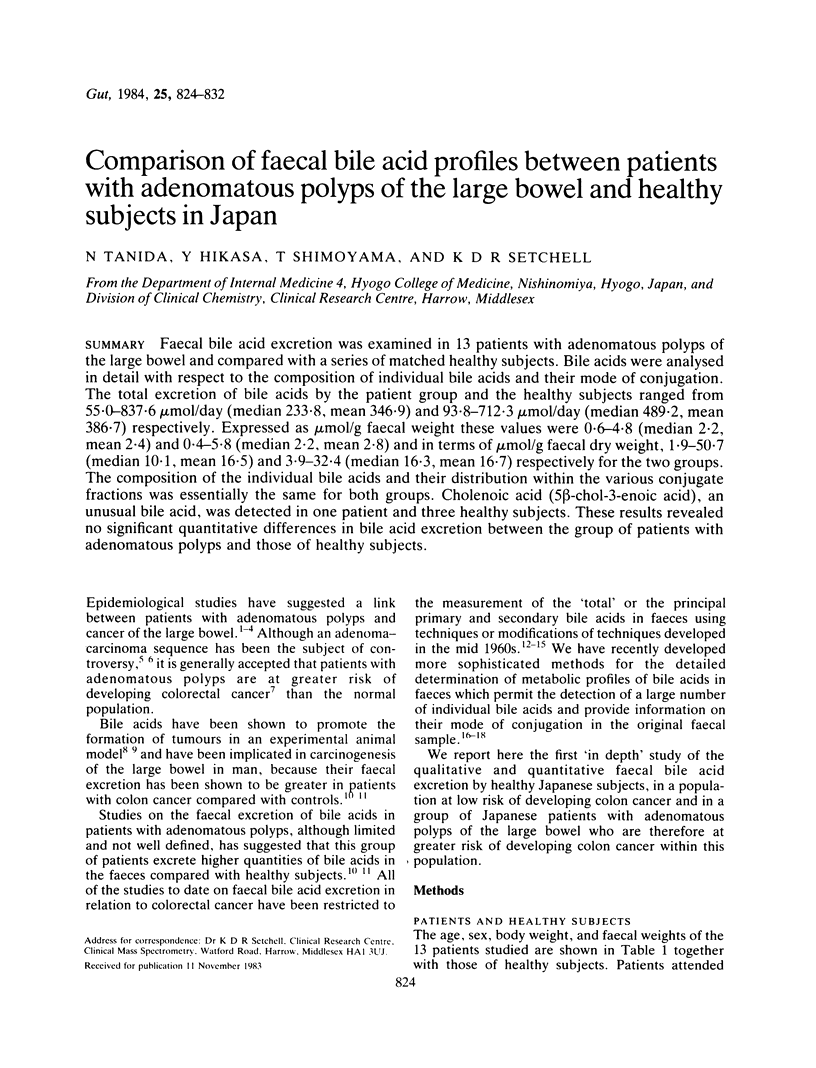
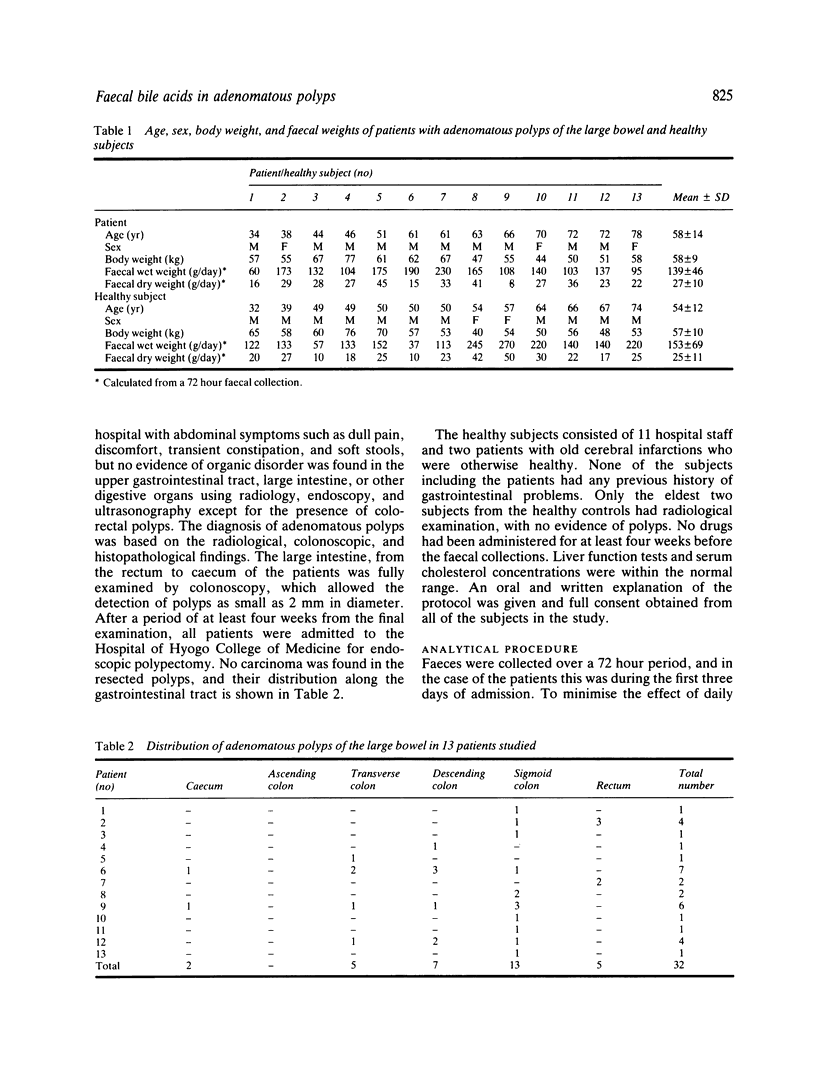
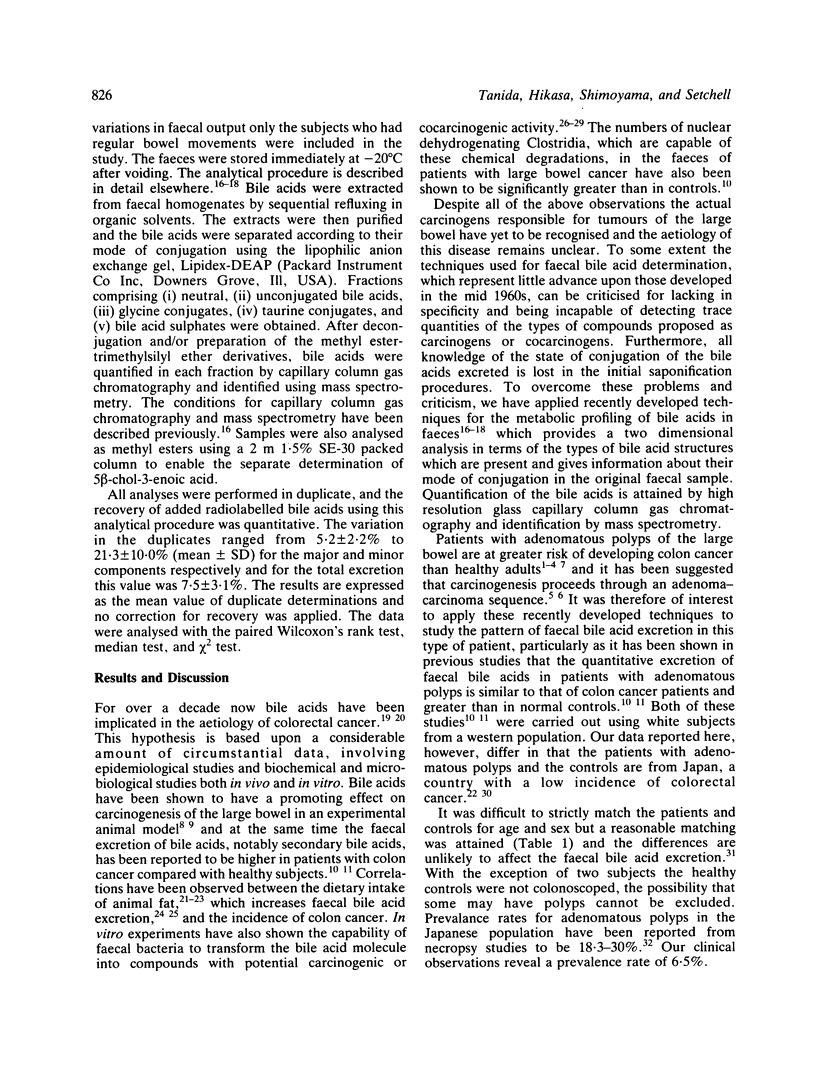
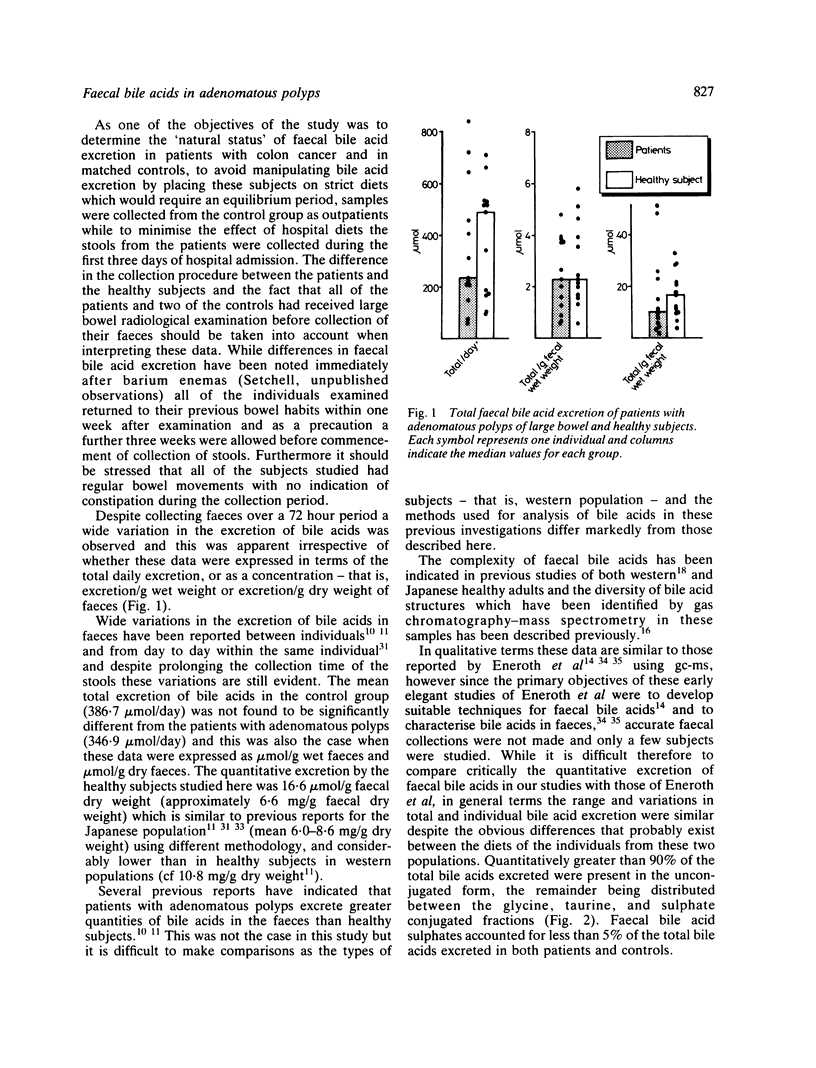
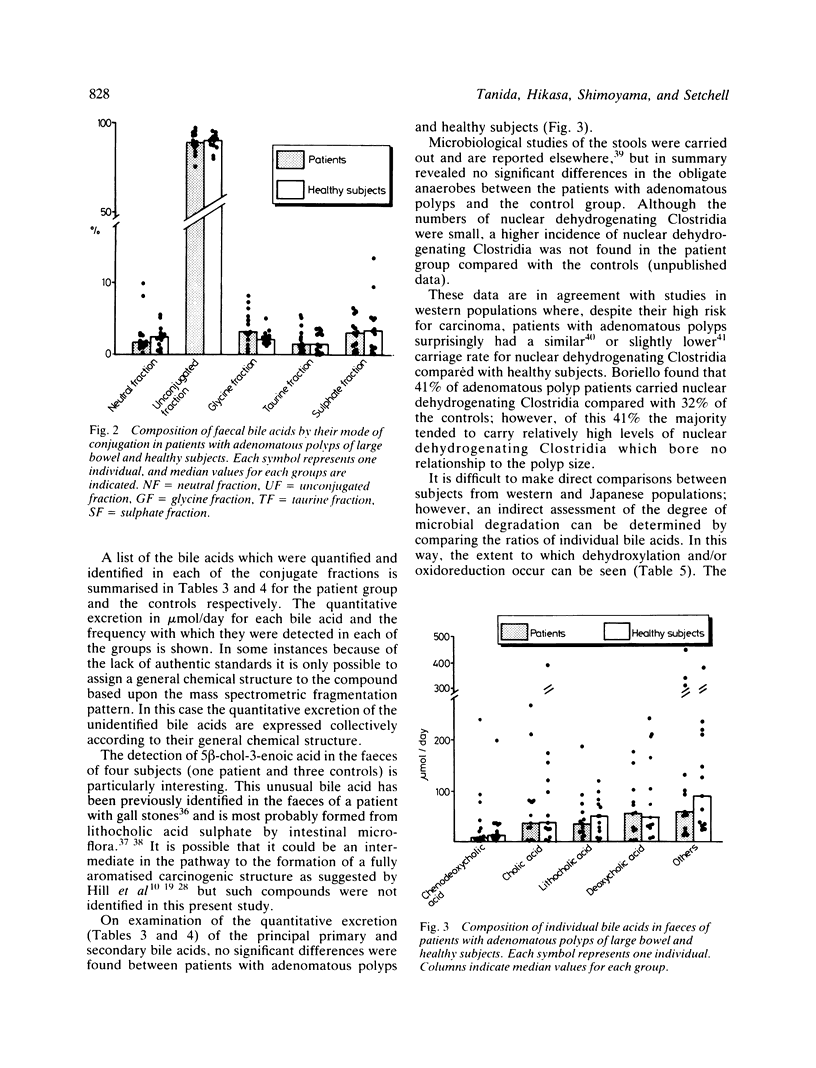
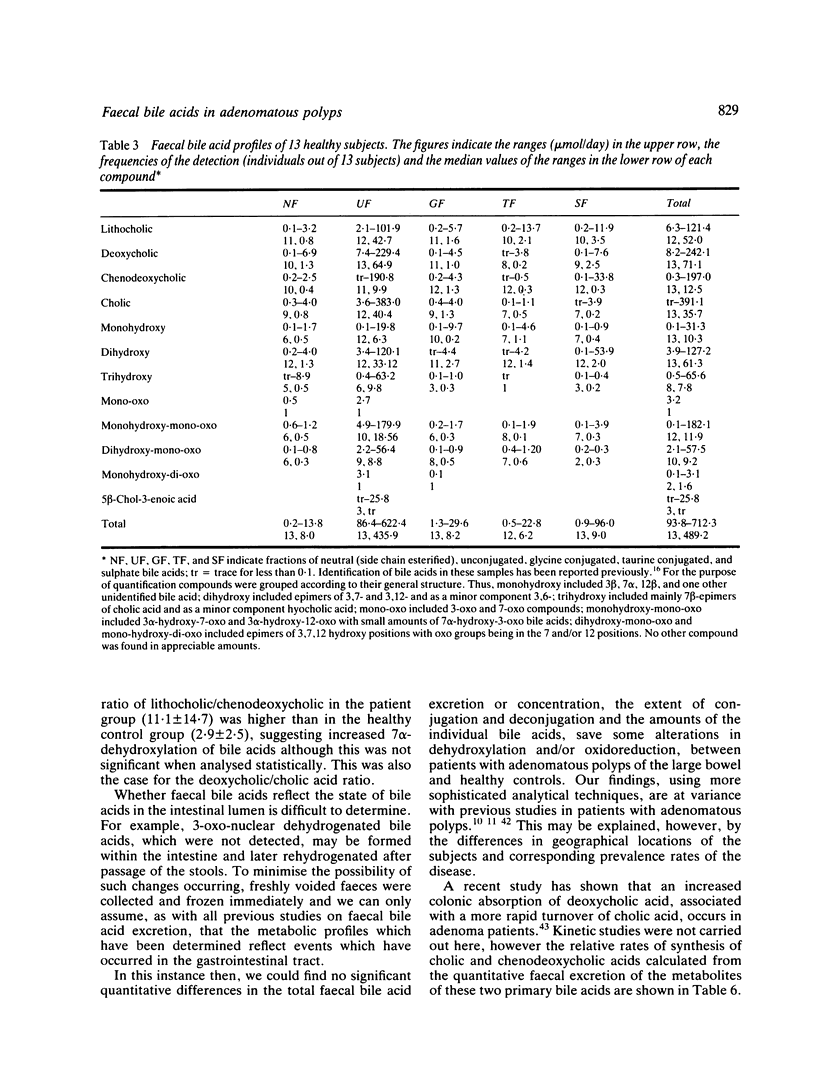
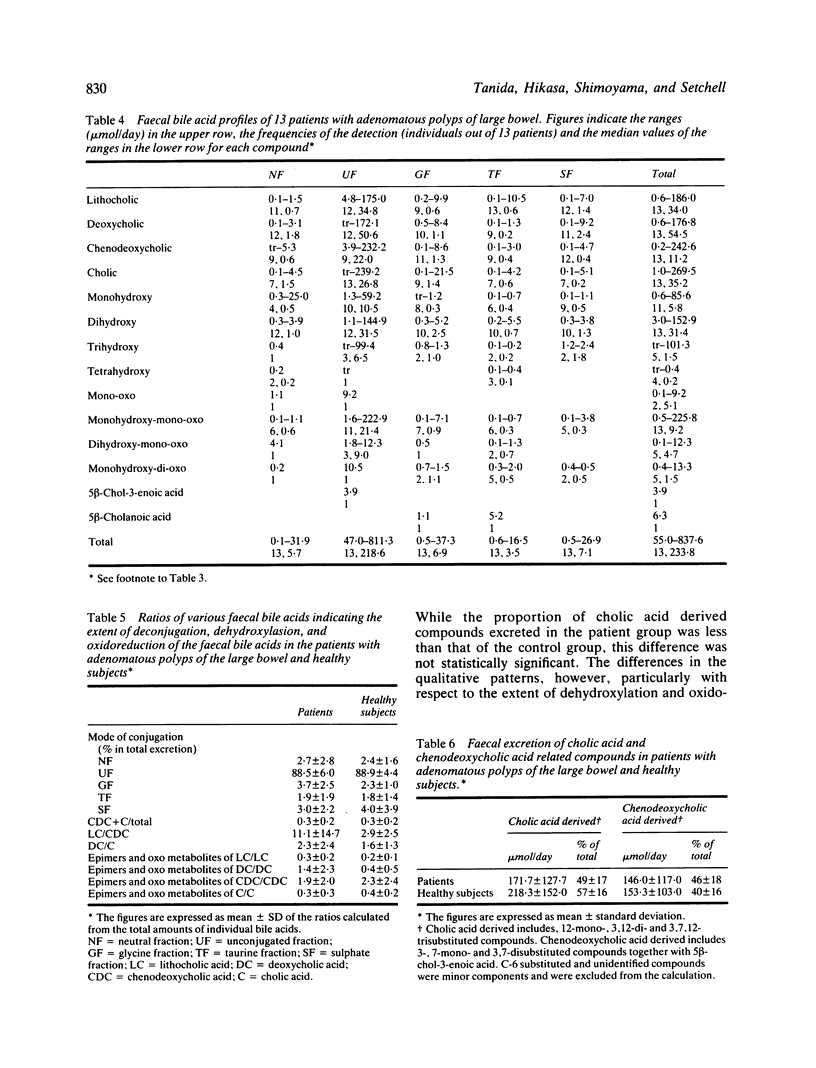
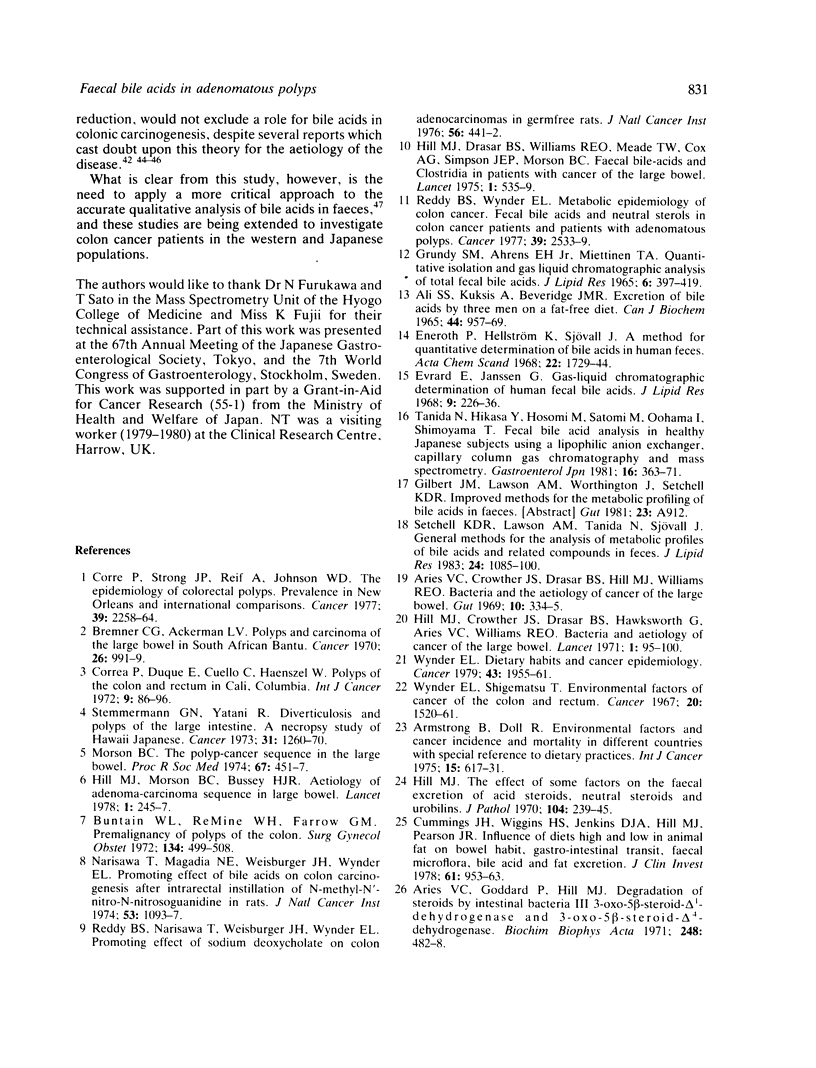
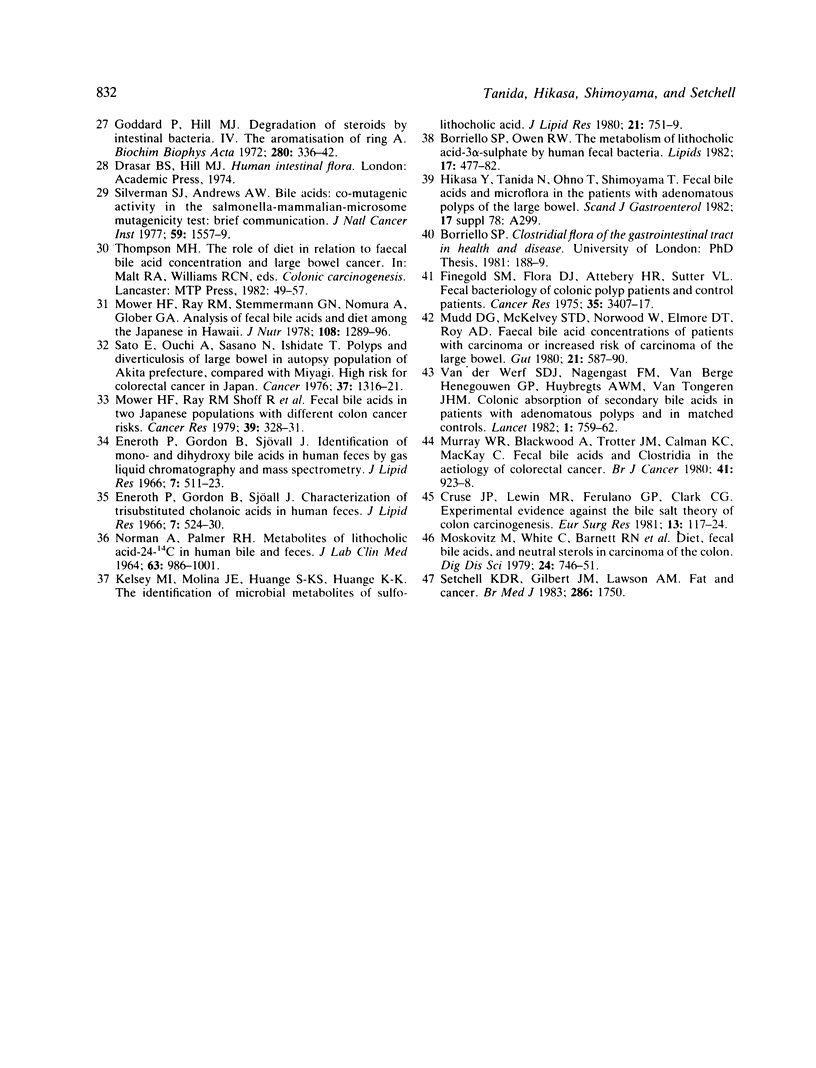
Selected References
These references are in PubMed. This may not be the complete list of references from this article.
- Ali S. S., Kuksis A., Beveridge J. M. Excretion of bile acids by three men on a fat-free diet. Can J Biochem. 1966 Jun;44(6):957–969. doi: 10.1139/o66-112. [DOI] [PubMed] [Google Scholar]
- Aries V., Crowther J. S., Drasar B. S., Hill M. J., Williams R. E. Bacteria and the aetiology of cancer of the large bowel. Gut. 1969 May;10(5):334–335. doi: 10.1136/gut.10.5.334. [DOI] [PMC free article] [PubMed] [Google Scholar]
- Armstrong B., Doll R. Environmental factors and cancer incidence and mortality in different countries, with special reference to dietary practices. Int J Cancer. 1975 Apr 15;15(4):617–631. doi: 10.1002/ijc.2910150411. [DOI] [PubMed] [Google Scholar]
- Borriello S. P., Owen R. W. The metabolism of lithocholic acid and lithocholic acid-3-alpha-sulfate by human fecal bacteria. Lipids. 1982 Jul;17(7):477–482. doi: 10.1007/BF02535328. [DOI] [PubMed] [Google Scholar]
- Bremner C. G., Ackerman L. V. Polyps and carcinoma of the large bowel in the South African Bantu. Cancer. 1970 Nov;26(5):991–999. doi: 10.1002/1097-0142(197011)26:5<991::aid-cncr2820260505>3.0.co;2-j. [DOI] [PubMed] [Google Scholar]
- Buntain W. L., ReMine W. H., Farrow G. M. Premalignancy of polyps of the colon. Surg Gynecol Obstet. 1972 Mar;134(3):499–508. [PubMed] [Google Scholar]
- Correa P., Duque E., Cuello C., Haenszel W. Polyps of the colon and rectum in Cali, Colombia. Int J Cancer. 1972 Jan 15;9(1):86–96. doi: 10.1002/ijc.2910090111. [DOI] [PubMed] [Google Scholar]
- Correa P., Strong J. P., Reif A., Johnson W. D. The epidemiology of colorectal polyps: prevalence in New Orleans and international comparisons. Cancer. 1977 May;39(5):2258–2264. doi: 10.1002/1097-0142(197705)39:5<2258::aid-cncr2820390545>3.0.co;2-s. [DOI] [PubMed] [Google Scholar]
- Cruse J. P., Lewin M. R., Ferulano G. P., Clark C. G. Experimental evidence against the bile salt theory of colon carcinogenesis. Eur Surg Res. 1981;13(2):117–124. doi: 10.1159/000128177. [DOI] [PubMed] [Google Scholar]
- Cummings J. H., Wiggins H. S., Jenkins D. J., Houston H., Jivraj T., Drasar B. S., Hill M. J. Influence of diets high and low in animal fat on bowel habit, gastrointestinal transit time, fecal microflora, bile acid, and fat excretion. J Clin Invest. 1978 Apr;61(4):953–963. doi: 10.1172/JCI109020. [DOI] [PMC free article] [PubMed] [Google Scholar]
- Eneroth P., Gordon B., Ryhage R., Sjövall J. Identification of mono- and dihydroxy bile acids in human feces by gas-liquid chromatography and mass spectrometry. J Lipid Res. 1966 Jul;7(4):511–523. [PubMed] [Google Scholar]
- Eneroth P., Gordon B., Sjövall J. Characterization of trisubstituted cholanoic acids in human feces. J Lipid Res. 1966 Jul;7(4):524–530. [PubMed] [Google Scholar]
- Eneroth P., Hellström K., Sjövall J. A method for quantitative determination of bile acids in human feces. Bile acids and steroids 195. Acta Chem Scand. 1968;22(6):1729–1744. doi: 10.3891/acta.chem.scand.22-1729. [DOI] [PubMed] [Google Scholar]
- Evrard E., Janssen G. Gas-liquid chromatographic determination of human fecal bile acids. J Lipid Res. 1968 Mar;9(2):226–236. [PubMed] [Google Scholar]
- Finegold S. M., Flora D. J., Attebery H. R., Sutter V. L. Fecal bacteriology of colonic polyp patients and control patients. Cancer Res. 1975 Nov;35(11 Pt 2):3407–3417. [PubMed] [Google Scholar]
- GRUNDY S. M., AHRENS E. H., Jr, MIETTINEN T. A. QUANTITATIVE ISOLATION AND GAS--LIQUID CHROMATOGRAPHIC ANALYSIS OF TOTAL FECAL BILE ACIDS. J Lipid Res. 1965 Jul;6:397–410. [PubMed] [Google Scholar]
- Goddard P., Hill M. J. Degradation of steroids by intestinal bacteria. IV. The aromatisation of ring A. Biochim Biophys Acta. 1972 Oct 5;280(2):336–342. doi: 10.1016/0005-2760(72)90101-4. [DOI] [PubMed] [Google Scholar]
- Hill M. J., Drasar B. S., Hawksworth G., Aries V., Crowther J. S., Williams R. E. Bacteria and aetiology of cancer of large bowel. Lancet. 1971 Jan 16;1(7690):95–100. doi: 10.1016/s0140-6736(71)90837-3. [DOI] [PubMed] [Google Scholar]
- Hill M. J., Drasar B. S., Williams R. E., Meade T. W., Cox A. G., Simpson J. E., Morson B. C. Faecal bile-acids and clostridia in patients with cancer of the large bowel. Lancet. 1975 Mar 8;1(7906):535–539. doi: 10.1016/s0140-6736(75)91556-1. [DOI] [PubMed] [Google Scholar]
- Hill M. J., Morson B. C., Bussey H. J. Aetiology of adenoma--carcinoma sequence in large bowel. Lancet. 1978 Feb 4;1(8058):245–247. doi: 10.1016/s0140-6736(78)90487-7. [DOI] [PubMed] [Google Scholar]
- Hill M. J. The effect of some factors on the faecal concentration of acid steroids, neutral steroids and urobilins. J Pathol. 1971 Aug;104(4):239–245. doi: 10.1002/path.1711040405. [DOI] [PubMed] [Google Scholar]
- Kelsey M. I., Molina J. E., Huang S. K., Hwang K. K. The identification of microbial metabolites of sulfolithocholic acid. J Lipid Res. 1980 Aug;21(6):751–759. [PubMed] [Google Scholar]
- Morson B. President's address. The polyp-cancer sequence in the large bowel. Proc R Soc Med. 1974 Jun;67(6 Pt 1):451–457. [PMC free article] [PubMed] [Google Scholar]
- Moskovitz M., White C., Barnett R. N., Stevens S., Russell E., Vargo D., Floch M. H. Diet, fecal bile acids, and neutral sterols in carcinoma of the colon. Dig Dis Sci. 1979 Oct;24(10):746–751. doi: 10.1007/BF01317206. [DOI] [PubMed] [Google Scholar]
- Mower H. F., Ray R. M., Shoff R., Stemmermann G. N., Nomura A., Glober G. A., Kamiyama S., Shimada A., Yamakawa H. Fecal bile acids in two Japanese populations with different colon cancer risks. Cancer Res. 1979 Feb;39(2 Pt 1):328–331. [PubMed] [Google Scholar]
- Mower H. F., Ray R. M., Stemmermann G. N., Nomura A., Glober G. A. Analysis of fecal bile acids and diet among the Japanese in Hawaii. J Nutr. 1978 Aug;108(8):1289–1296. doi: 10.1093/jn/108.8.1289. [DOI] [PubMed] [Google Scholar]
- Mudd D. G., McKelvey S. T., Norwood W., Elmore D. T., Roy A. D. Faecal bile acid concentration of patients with carcinoma or increased risk of carcinoma in the large bowel. Gut. 1980 Jul;21(7):587–590. doi: 10.1136/gut.21.7.587. [DOI] [PMC free article] [PubMed] [Google Scholar]
- NORMAN A., PALMER R. H. METABOLITES OF LITHOCHOLIC ACID-24-C-14 IN HUMAN BILE AND FECES. J Lab Clin Med. 1964 Jun;63:986–1001. [PubMed] [Google Scholar]
- Narisawa T., Magadia N. E., Weisburger J. H., Wynder E. L. Promoting effect of bile acids on colon carcinogenesis after intrarectal instillation of N-methyl-N'-nitro-N-nitrosoguanidine in rats. J Natl Cancer Inst. 1974 Oct;53(4):1093–1097. doi: 10.1093/jnci/53.4.1093. [DOI] [PubMed] [Google Scholar]
- Reddy B. S., Narasawa T., Weisburger J. H., Wynder E. L. Promoting effect of sodium deoxycholate on colon adenocarcinomas in germfree rats. J Natl Cancer Inst. 1976 Feb;56(2):441–442. doi: 10.1093/jnci/56.2.441. [DOI] [PubMed] [Google Scholar]
- Reddy B. S., Wynder E. L. Metabolic epidemiology of colon cancer. Fecal bile acids and neutral sterols in colon cancer patients and patients with adenomatous polyps. Cancer. 1977 Jun;39(6):2533–2539. doi: 10.1002/1097-0142(197706)39:6<2533::aid-cncr2820390634>3.0.co;2-x. [DOI] [PubMed] [Google Scholar]
- Sato E., Ouchi A., Sasano N., Ishidate T. Polyps and diverticulosis of large bowel in autopsy population of Akita prefecture, compared with Miyagi. High risk for colorectal cancer in Japan. Cancer. 1976 Mar;37(3):1316–1321. doi: 10.1002/1097-0142(197603)37:3<1316::aid-cncr2820370312>3.0.co;2-#. [DOI] [PubMed] [Google Scholar]
- Setchell K. D., Gilbert J. M., Lawson A. M. Fat and cancer. Br Med J (Clin Res Ed) 1983 May 28;286(6379):1750–1750. doi: 10.1136/bmj.286.6379.1750. [DOI] [PMC free article] [PubMed] [Google Scholar]
- Setchell K. D., Lawson A. M., Tanida N., Sjövall J. General methods for the analysis of metabolic profiles of bile acids and related compounds in feces. J Lipid Res. 1983 Aug;24(8):1085–1100. [PubMed] [Google Scholar]
- Silverman S. J., Andrews A. W. Bile acids: co-mutagenic activity in the Salmonella-mammalian-microsome mutagenicity test: brief communication. J Natl Cancer Inst. 1977 Nov;59(5):1557–1559. doi: 10.1093/jnci/59.5.1557. [DOI] [PubMed] [Google Scholar]
- Tanida N., Hikasa Y., Hosomi M., Satomi M., Oohama I., Shimoyama T. Fecal bile acid analysis in healthy Japanese subjects using a lipophilic anion exchanger, capillary column gas chromatography and mass spectrometry. Gastroenterol Jpn. 1981;16(4):363–371. doi: 10.1007/BF02774469. [DOI] [PubMed] [Google Scholar]
- Wynder E. L. Dietary habits and cancer epidemiology. Cancer. 1979 May;43(5 Suppl):1955–1961. doi: 10.1002/1097-0142(197905)43:5+<1955::aid-cncr2820430702>3.0.co;2-k. [DOI] [PubMed] [Google Scholar]
- Wynder E. L., Shigematsu T. Environmental factors of cancer of the colon and rectum. Cancer. 1967 Sep;20(9):1520–1561. doi: 10.1002/1097-0142(196709)20:9<1520::aid-cncr2820200920>3.0.co;2-3. [DOI] [PubMed] [Google Scholar]
- van der Werf S. D., Nagengast F. M., van Berge Henegouwen G. P., Huijbregts A. W., van Tongeren J. H. Colonic absorption of secondary bile-acids in patients with adenomatous polyps and in matched controls. Lancet. 1982 Apr 3;1(8275):759–762. doi: 10.1016/s0140-6736(82)91810-4. [DOI] [PubMed] [Google Scholar]


